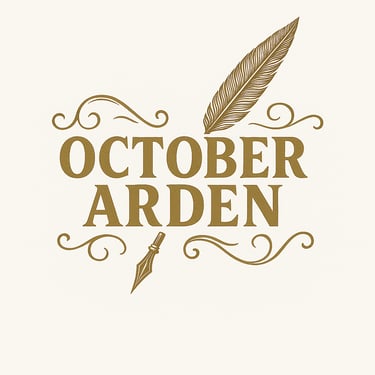Writing Tools I Can’t Live Without (as a Neurospicy, Chronically Ill Author)
7/30/20253 min read
As someone who navigates the beautiful chaos of being neurodivergent and chronically ill while trying to coax stories from my brain-fog-addled mind, I've learned that the right tools can make the difference between writing and... well, staring at a blank document while my thoughts scatter like startled pigeons.
These aren't just preferences—they're accessibility adaptations that transform impossible writing days into possible ones. After years of trial and error (and more error), here's my survival kit for creating queer stories when your body and brain have other plans.
1. The Holy Trinity: Laptop + ProWriting Aid + Exercise Ball Throne
My Laptop: The Keeper of Chaos
My laptop isn't just a device—it's the archive of my heart, the keeper of my literary chaos. More importantly, it's the only reason I can write horizontally during flares when sitting upright feels like negotiating with gravity and losing.
ProWriting Aid: Spellcheck on Steroids
This isn't your basic grammar checker. ProWriting Aid is like having a patient editor who doesn't judge my 3 AM comma splices or my protagonist's fourth existential crisis in Chapter 2. For ADHD writers, it's particularly effective because it chunks feedback to prevent overwhelm and highlights one issue at a time. The visual representations of writing statistics work brilliantly for neurodivergent writers who benefit from graphical feedback.
Giant Inflatable Exercise Ball "Chair"
Chronic inflammation + ADHD = normal chairs are my nemesis. This magnificent bouncing throne lets me wiggle, bounce, and occasionally roll away mid-sentence when the writing gets too intense. Research published in the American Journal of Occupational Therapy found that students with ADHD using therapy balls showed improved behavior and increased legible word productivity. The constant micro-movements help channel hyperactivity into productivity while addressing the blood pooling issues common with POTS and dysautonomia.
Bonus: It absolutely terrifies the squirrels outside my window, which provides excellent entertainment during writing breaks.
2. The Brain Dump Journal (aka "Useless Thoughts Cemetery")
This unassuming notebook serves as the final resting place for doubts, to-do lists, and existential screeches. Therapeutic journaling tools specifically designed for chronic conditions help manage the mental load of symptoms while preserving creative energy. For ADHD writers who struggle with intrusive thoughts disrupting focus, externalizing racing thoughts is crucial.
Sample entries from the cemetery:
"Why does editing feel like chewing aluminum foil?"
"Buy more eczema cream (THE MEDICATED ONE NOT THE REGULAR)."
"You're not a fraud, just a raccoon with a laptop. Keep going."
The mix of practical reminders with self-compassion mirrors strategies used successfully by chronically ill writers who must balance health management with creative output.
3. Pentel EnerGel Pens: A Sensory Love Letter
STOP. PUT DOWN THAT PILOT G-2. I NEED YOU TO UNDERSTAND:
As a person with ADHD and sensory sensitivities, I've tested approximately all the pens on earth. The Pentel EnerGel is the smoothest, fastest, most blissful writing experience—like butter on hot glass. ADHD and autistic writers frequently report that the "wrong" pen creates a barrier to accessing their thoughts. The EnerGel's smooth, fast-flowing ink reduces the sensory friction that can derail hyperfocus states.
Color Obsessions:
Dark greens (forest, olive—proof I was a frog in a past life)
Bright teal (for when my brain needs a jolt)
Magenta (currently my favorite—vibrant but still readable)
Your color preferences may align with sensory processing research showing that neurodivergent individuals often have strong color preferences that affect their ability to concentrate and process information. The fact that lighter colors are harder for you to read may indeed be connected to neurodivergence, as visual processing differences are common in ADHD and autistic individuals.
Note: Fountain pens are reserved for serious journaling—because capping/uncapping is a focus-killer. Pilot, I love you, but your retractable fountain pen and I have trust issues.
4. ADHD Survival Kit
Phone Lockbox
Because doomscrolling is the enemy of deadlines. Research shows that ADHD individuals check their phones up to 300 times daily, making physical barriers more effective than app-based restrictions. The forced "work or be bored" state often results in productive hyperfocus.
Pomodoro Timers
15 minutes of work, 5 minutes of staring at the ceiling questioning my life choices. The shorter work intervals provide frequent dopamine hits through task completion while preventing mental fatigue.
Fidget Toys
Currently a chewed-up keyring and mini scissors (don't ask). These serve as stims—self-regulating behaviors that help maintain attention and reduce anxiety in neurodivergent individuals.
Tibetan Singing Bowl
For banishing imposter syndrome (works 60% of the time, every time). Sometimes you need to sonically reset your brain's anxiety frequency.
5. The "My Body Betrayed Me" Essentials
Desk Fan
Dysautonomia means my internal thermostat is broken. Fan on = too cold. Fan off = spontaneous combustion. This addresses temperature dysregulation common in autonomic dysfunction.
Gallon of Water
Hydrate or literally die (thanks, POTS). The increased fluid needs reflect the medical requirements for managing POTS symptoms.
Post-its
For the 47 reminders I'll immediately lose. These address the executive dysfunction challenges that chronically ill writers face, where cognitive fog and fatigue impact memory and organization.
6. The Most Important Tool: Gratitude
For the days when words flow, for the days they don't, and for the privilege of writing queer, disabled, neurodivergent stories—even when it feels impossible.
Self-compassion and acknowledging limitations without shame are consistently identified as crucial elements for sustainable creative practices among disabled writers.


